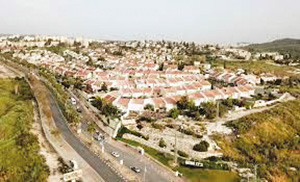
(Courtesy of B’sheva) “Beit Shemesh of 2022 is the state of Israel of 2042,” describes mayor Dr. Eliza Bloch when asked to describe the very being of Beit Shemesh in the microcosmos of the Israeli society in a single sentence. She adds, regarding Beit Shemesh’s challenges “We rather see every challenge as an opportunity and not as a burden.”
Beit Shemesh is located between metropolitan Jerusalem and metropolitan Tel Aviv. The city is home to over 150 thousand citizens. Surrounding Beit Shemesh are many archeological remains that testify to it being an ancient village near Beit Shemesh dating all the way back to the bronze age. Beit Shemesh was founded in 1951 and officially became a city in 1991.
Dr. Bloch says: “Beit Shemesh is a very youthful city. Beit Shemesh includes 45 thousand students varying in ages from elementary school through high school. Beit Shemesh is not only a young city, but is also a city that is home to multiple communities. A city where its citizens, in the mission of strengthening the knot between different communities, tighten that knot every day. The city is home to traditional Jews, Orthodox Jews, Reform Jews and non-religious Jews. That same urban community diversity is not just in between communities, but also diversity within themselves.”
Dr. Bloch concludes her thoughts by saying: “The story of the state of Israel is the story of the city of Beit Shemesh, a bus station in Beit Shemesh is, in every given moment, a capsule of being an Israeli citizen.”
A mere visit to Beit Shemesh will show you that the city is in the process of accelerated development into axes. The first axis is the world of economical development. The industrial areas are marketed successfully, executive entrepreneurs transfer their main activities and offices to Beit Shemesh. A new unique employment manager has been hired, whose purpose is to lead new entrepreneurs to act and to invest in the city, while subsequently creating training processes and motivation for the citizens. The city is going through a revolution of economic efficiency. Every single street light has been substituted with LED lighting, solar panels have been put over educational facilities and sports fields.
The second development axis is the city’s housing. Tens of thousands of housing units are part of
the housing process in different neighborhoods throughout the heterogeneous population. In ancient Beit Shemesh housing is up for rent and there is now a manager for urban development.
Alongside the main developing areas, other developing projects are also being created: Beit Shemesh is under a major cultural development uprising. In the past year, Beit Shemesh’s very first cultural center has been founded, built to suit all the different communities. This year, different festivals have taken place, and at its main event, “Beit Shemesh Festival,” during the Shabbat of Passover, tens of thousands of citizens enjoyed different activities. Just a few days ago “House Of Artists” was showcased to the city’s artists.
In addition, the educational field has been under development and has been just as much in focus in Beit Shemesh. Hundreds of new classrooms for different communities that live in the city have been built in the past year. The world of educational facilities has been growing and developing due to the developing educational system. Beit Shemesh has become the capital of ultra-Orthodox state education for the state of Israel. Every year, new educational facilities open for the Orthodox community.
What is Beit Shemesh’s image? A race. The city’s mayor and her team wake up every single day to the wonderful creations and new developments. There is also a yearly race in Beit Shemesh, in addition, a brand new women’s race has been in development.
Dr. Bloch concludes:“We are leading Beit Shemesh through an ideal of ‘education for responsibility;’ this is an ideal based on our connection to the city’s citizens as partners. This ideal comes to life through different initiations such as the citywide cleaning and recycling day, a special event for developing communal responsibility, and more influential initiations to support Beit Shemesh’s ideal. A citizen that feels like he is a partner, a part of something big, is a more engaged citizen and I believe that is my mission.”









